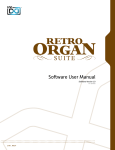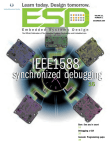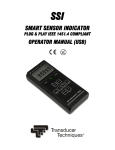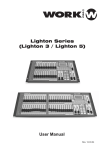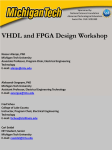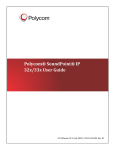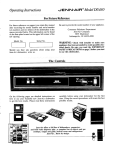Download The art of construction The art of construction
Transcript
The Official Publication of The Embedded Systems Conferences and Embedded.com JANUARY 2008 VOLUME 21, NUMBER 1 Learn today • Design tomorrow >> Saks: All about scope p.9 >> Symmetric multiprocessing p.28 >> Debugging embedded C p.34 >> Ganssle: 20 years ago p.45 The art of FPGA construction p. 14 90% CUT IN EMISSIONS AND 50% CUT IN DEVELOPMENT TIME. THAT’S MODEL-BASED DESIGN. To meet a tough performance target, the engineering team at Nissan used dynamic system models instead of paper specifications. The result: 50% time savings, the first car certified to meet California’s Partial Zero Emissions Vehicle standard, and a U.S. EPA award. To learn more, visit mathworks.com/mbd Accelerating the pace of engineering and science ©2005 The MathWorks, Inc. Need to make sure they line up for your product first? With more than half of the product development cycle consumed by debugging, finding bugs faster means your product will get to market first. Green Hills Software provides premier tools that pinpoint the most elusive bugs in minutes, instead of hours or days. With the MULTI ® development environmentʼs time-saving code analysis tools, errors in code are automatically found, long before the debugging process begins. MULTI and the TimeMachine™ debugger allow developers to easily find every bug so that shipping a product with known problems becomes a thing of the past. With Green Hills Softwareʼs sophisticated technology youʼll produce a better product and get it out the door long before your competition. Call 800-765-4733 or visit us on the web www.ghs.com to learn more. Copyright © 2006 Green Hills Software, Inc. Green Hills, the Green Hills logo, MULTI and TimeMachine, are trademarks or registered trademarks of Green Hills Software, Inc. in the U.S. and/or internationally. All other trademarks are the property of their respective owners. Perforce Fast Software Configuration Management Introducing Time-lapse View, a productivity feature of Perforce SCM. Time-lapse View lets developers see every edit ever made to a file in a dynamic, annotated display. At long last, developers can quickly find answers to questions such as: ‘Who wrote this code, and when?’ and ‘What content got changed, and why?’ Time-lapse View features a graphical timeline that visually recreates the evolution of a file, change by change, in one fluid display. Color gradations mark the aging of file contents, and the display’s timeline can be configured to show changes by revision number, date, or Perforce Time-lapse View changeset number. Time-lapse View is just one of the many productivity tools that come with the Perforce SCM System. Download a free copy of Perforce, no questions asked, from www.perforce.com. Free technical support is available throughout your evaluation. THE OFFICIAL PUBLICATION OF THE EMBEDDED SYSTEMS CONFERENCES AND EMBEDDED.COM columns programming pointers OO9 Storage class specifiers and storage duration BY DAN SAKS www.embedded.com JANUARY 2008 VOLUME 21, NUMBER 1 Cover Feature: The art of FPGA construction BY GINA R. SMITH Working with FPGAs isn’t intimidating when you know the basic techniques and options. OO14 break points Twenty years on OO45 BY JACK G. GANSSLE Twenty years is a long time in human terms and even longer in the microprocessor industry. Here’s a look at what’s transpired. departments Is symmetric multiprocessing for you? BY DAVID N. KLEIDERMACHER Multicore architectures can provide the performance boost you’re looking for, but the software is certainly more complicated. 28RR Storage class specifiers don’t specify scope but combine with scope to determine storage duration. Here’s the second part in a series on scope, storage allocation, and linkage. Debugging embedded C BY ROBIN KNOKE Has debugging embedded C changed in 20 years? You betcha. But the process will never change: stabilize, isolate, correct, and retest. Here’s an article from the 1988 premiere issue of Embedded Systems Programming, with some comments from the author, Robin Knoke. #include Acquisitions to enhance coverage OO4 BY RICHARD NASS Acquisitions will bring more tear downs and insight into semiconductors. parity bit OO7 advertising index OO43 marketplace OO47 in person ESC Silicon Valley San Jose Convention Center April 14–18, 2008 www.embedded.com/esc/sv/ on-line www.embedded.com OO34 Web archive: www.embedded.com/archive Article submissions: www.embedded.com/wriguide Forum discussions: www.embedded.com/forum EMBEDDED SYSTEMS DESIGN (ISSN 1558-2493 print; ISSN 1558-2507 PDF-electronic) is published monthly by CMP Media LLC., 600 Harrison Street, 5th floor, San Francisco, CA 94107, (415) 947-6000. Please direct advertising and editorial inquiries to this address. SUBSCRIPTION RATE for the United States is $55 for 12 issues. Canadian/Mexican orders must be accompanied by payment in U.S. funds with additional postage of $6 per year. All other foreign subscriptions must be prepaid in U.S. funds with additional postage of $15 per year for surface mail and $40 per year for airmail. POSTMASTER: Send all changes to EMBEDDED SYSTEMS DESIGN, P.O. Box 3404, Northbrook, IL 60065-9468. For customer service, telephone toll-free (877) 676-9745. Please allow four to six weeks for change of address to take effect. Periodicals postage paid at San Francisco, CA and additional mailing offices. EMBEDDED SYSTEMS DESIGN is a registered trademark owned by the parent company, CMP Media LLC. All material published in EMBEDDED SYSTEMS DESIGN is copyright © 2005 by CMP Media LLC. All rights reserved. Reproduction of material appearing in EMBEDDED SYSTEMS DESIGN is forbidden without permission. #include BY Richard Nass Editor in Chief Richard Nass (201) 288-1904 [email protected] Acquisitions to enhance coverage E mbedded systems designers can now gain from the experience of their peers, thanks to an abundance of Tear Downs. CMP, the company that owns this magazine, Embedded.com, and the Embedded Systems Conferences (along with lots of other publications and Web sites, including EE Times and TechOnline), recently made two acquisitions. Normally, I wouldn’t mention events that occurred on the business side of the house in these pages. However, these two acquisitions could have a great affect on the coverage that you’ll see in these pages. The two acquisitions are Semiconductor Insights (www.semiconduc tor.com) and Portelligent (www.tear down.com). If you’re not familiar with one or both of these companies, let me shed some light on them. The Portelligent acquisition was finalized in November. The company’s claim to fame is doing Tear Downs. By doing that, they gain intelligence into the design of mobile, wireless, personal, and consumer electronics. With this information, designers can make faster, better, and more cost-effective decisions about their competitive positioning, technology options, investment strategy, intellectual property (IP) position, and marketplace opportunities. Portelligent was formed in 2000 as a spinoff of an Austin-based research consortium. We’ve worked with the Portelligent team for years. You may have noticed that the company’s Tear Downs have been appearing in our pages and on Embedded.com for some time now, as well as in EE Times and on TechOnline. You may also recognize the Portelligent name from the Prius Tear Downs we performed live at the Embedded Systems Conferences. The company had a big hand in that project. The acquisition of Semiconductor Insights, which occurred last July, has a similar meaning to our group. Semiconductor Insights is also known for its Tear Downs, but they perform them at the IC level rather than at the system level. For example, the company was the first to tear apart and analyze Intel’s latest microprocessor, the Penryn 45-nm device. Semiconductor Insights also serves as a global IP and patent technical advisor. They have the ability to perform technical investigations of patents, ICs, and electronic systems. One division of the company benchmarks competing devices, improves time to market, and solves technical problems, while a second division helps technology companies and legal professionals evaluate, develop, and monetize their IP. Together, the two companies will offer a combined searchable database of over 40,000 components and ICs, which is an invaluable resource for designers. Managing Editor Susan Rambo [email protected] Contributing Editors Michael Barr John Canosa Jack W. Crenshaw Jack G. Ganssle Dan Saks Larry Mittag Art Director Debee Rommel [email protected] European Correspondent Colin Holland [email protected] Embedded.com Site Editor Bernard Cole [email protected] Production Manager Pete Scibilia [email protected] Director of Audiences Services Kristi Cunningham [email protected] Subscription Customer Service P.O. Box 2165, Skokie, IL 60076 (800) 577-5356 (toll free), Fax: (847) 763-9606 [email protected] www.embeddedsystemsdesigncustomerservice.com Back Issues Kelly Minihan (800) 444-4881 (toll free), Fax: (785) 838-7566 Article Reprints, E-prints, and Permissions PARS International Corp. 102 West 38th Street, Sixth Floor New York, NY 10018 (212) 221-9595, Fax: (212) 221-9195 [email protected] www.magreprints.com.quickquote.asp Publisher David Blaza (415) 947-6929 [email protected] Editorial Review Board Michael Barr Jack W. Crenshaw Jack G. Ganssle Bill Gatliff Nigel Jones Niall Murphy Dan Saks Miro Samek Corporate David Levin Scott Mozarsky Tony Uphoff Robert Faletra Paul Miller Philip Chapnick Anne Marie Miller Marvlieu Jolla Hall Marie Myers Alexandra Raine Richard Nass is editor in chief of Embedded Systems Design. You can reach him at [email protected]. 4 JANUARY 2008 embedded systems design www.embedded.com Richard Nass [email protected] Chairman Chief Financial Officer President, CMP Business Technology Group President, CMP Channel President, CMP Electronics Group President, CMP Game, Dobb's, ICMI Group Corporate Senior Vice President, Sales Senior Vice President, Human Resources Senior Vice President, Manufacturing Senior Vice President, Communications SMIlE, MaRS! ThreadX RTOS manages camera software critical to NaSa mission ® “We found ThreadX to be a proven solution based on its demonstrated success for the Deep Impact mission, so using it for the HiRISE instrument aboard the MRO was a logical decision. ThreadX delivered a first-rate performance for us and helped the MRO mission return extraordinary high-resolution images from Mars.” – Steve Tarr, HiRISE Software Lead, Ball Aerospace & Technologies Corp. Images courtesy NASA: http://mars.jpl.nasa.gov/mro MRO spacecraft depicted in Mars orbit: NASA The Mission Opportunity Rover When they wrote the embedded software that controls the cameras aboard the Mars Reconnaissance Orbiter (MRO), a team of Ball Aerospace and Technology Corp. engineers led by Steve Tarr knew they only had one chance to get it right. If there was a seriT H R E A D ous flaw anywhere in the software, the $720 million spacecraft might have no more value than a digital camera dropped in a bathtub. Tarr and his team wrote 20,000 lines of code and used Express Logic's ThreadX RTOS. The software has worked flawlessly, resulting in history-making photographs such as the one to the left that shows the Opportunity rover traversing the surface of Mars. The Technology With its intuitive API, rock-solid reliability, small memory footprint, and high-performance, ThreadX delivered the goods for NASA's MRO. ThreadX is in over 450 million electronic devices from NASA's MRO to HP's printers and digital cameras. Which RTOS will you choose for YOUR next project? Order today on Amazon Real-Time Embedded Multithreading Using ThreadX and ARM by Edward L. Lamie Small Memory Footprint • Fast Context Switch • Fast Interrupt Response Preemption-Threshold™ Technology • Picokernel™ Design • Event Chaining™ Broad Tools Support • Supports All Leading 32/64-bit Processors • Easy to Use Full Source Code • Royalty-Free For a free evaluation copy, visit www.rtos.com • 1-888-THREaDX Copyright © 2007, Express Logic, Inc. ThreadX is a registered trademark of Express Logic, Inc. All other trademarks are the property of their respective owners. Embedded Unlock your future Enter the New Era of Configurable Embedded Processing Adapt to changing algorithms, protocols and interfaces, by creating your next embedded design on the world' s most flexible system platform. With the latest processing breakthroughs at your fingertips, you can readily meet the demands of applications in automotive, industrial, medical, communications, or defense markets. Architect your embedded vision Get the Complete Embedded Solution • Choose MicroBlaze™, the only 32-bit soft processor with a configurable MMU, or the industry-standard 32-bit PowerPC ® architecture • Select the exact mix of peripherals that meet your I/O needs, and stitch them together with the new optimized CoreConnect ™ PLB bus Build, program, debug . . . your way • Port the OS of your choice including Linux 2.6 for PowerPC or MicroBlaze • Reduce hardware/software debug time using Eclipse-based IDEs together with integrated ChipScope™ analyzer Eliminate risk & reduce cost Linux 2.6 www.xilinx.com/processor • No worry of processor obsolescence with Xilinx Embedded Processing technology and a range of programmable devices • Reconfigure your design even after deployment, reducing support cost and increasing product life Order your complete development kit today, and unlock the future of embedded design. www.xilinx.com/processor At the Heart of Innovation ©2007 Xilinx, Inc. All rights reserved. XILINX, the Xilinx logo, and other designated brands included herein are trademarks of Xilinx, Inc. All other trademarks are the property of their respective owners. www.embedded.com/forum parity bit Remembering transistor history N ley! Mr. Shockley! I connected p mate- the Thread-X RTOS. I have seen over ice article (Jack Ganssle, “The a dozen surveys that show the exact rial to n material to p material, injecttransistor: sixty years old and ed some current, and I am getting am- opposite of the one cited in this artistill switching,” December cle—where the use of Linux is on the plification!” Shockley looked over the 2007, p. 53). One minor point: before rise in embedded devices and (espetop of his magazine and said “Conthe galena and cat’s whiskers, there cially) in small handheld devices that gratulations! You just discovered the was the “coherer,” a strange concocmust display rich-content from the Shockley Effect!” tion of metal filings between two elec—Ed Wozniak Internet. trodes. It exhibited a large resistance Linux as applied to embedded sysdrop when subjected to an RF signal tems has a steep learning from the antenna that curve. Once you’re past that, would sound a bell and vi“Congratulations! You just it’s smooth sailing. But, Linux brate the device back to its discovered the Shockley Effect!” has its place. Personally, I like high-resistance state (for OpenBSD, because of its focus on corIn 1968, I was a sophomore engineerCW only, of course, not telephony.) A rectness and security. OpenBSD will ing physics major at the University of Google search on “coherer” yields only run (at this time) on machines Illinois. Bardeen was teaching E&M. some fascinating references, including that have an MMU, so it will not fit Articulate, lucid, and very friendly— DIY coherers for the curious—they well on certain desirable platforms. he put the material at the right level actually work! After the coherer came There’s a place for assembly, for C, for and pulled us along through a course the “magnetic detector”—IIRC, a a FORTH-based system, for a “home that was universally dreaded. Academoving band of iron. grown” RTOS, for a commercial —Roger Jones mia could use a few thousand more professors with his ability to teach and RTOS, for a free RTOS, and of course for Linux (and its BSD sisters and engage young minds. My father worked for RCA as an engi—David Barr brothers). Remember the old saying: neer from the ’50s through the ’70s. “If all you have is a hammer, then One year at the open house during the every problem looks like a nail.” One Christmas holidays, they gave us all an It’s not all about Linux The statement that “an estimated 70% should not fall in love with any one inhouse history of RCA. The founder of new semiconductor devices are Lin- technique. of RCA, David Sarnoff, was a teenage Linux is not for tiny microconux-enabled” seems quite impossible telegrapher for the Marconi company (Hadi Nahari and Jim Ready, “Employ trollers—you need at least a 32-bit maand was on duty when RMS Titanic chine with at least tens of megabytes of a secure flavor of Linux,” October went down. He manned his key for memory. (However, the trend in mimany hours, compiling lists of the sur- 2007, p. 20). A lot of LED and diodes crocontrollers is to migrate to 32-bits are being made, even today. Even if vivors, the missing, and the dead. This story, along with many others, encour- “semiconductor devices” is changed to and memory is becoming very inexpensive). Linux is great if what you aged me to enter this field. How far we read “microprocessor,” it seems very want is a standard (and open) platunlikely to be true, given the quantihave come in just the 60 years of the form with extensive networking supties of low-end controllers shipped in transistor and the 100 years or so of port, and lots of already written and small gadgets. Can you point to any electronics? What will the next 100 ready-to-go standard applications. justification for this statement? years hold? —Craig Cherry That’s why Linux is becoming very —Thomas Mazowiesky popular on upscale cellular phones and handheld PCs. If all you need to It’s not all about operating systems While I was working at Bell Laboratodo is read a sensor and send a packet ries in the late 1970s, a story was going Mr. Carbone could not possibly have somewhere over TCP/IP, there are betan “ax to grind,” could he? (John Cararound about the invention of the ter solutions, (and not all of them cost bonne, “Embedded OS trends points transistor. It seems that one day Bill to Linux . . . sometimes,” online Guest a lot of money like the Thread-X Shockley was sitting in his office readEditor column, 12/11/07.) After all, he RTOS). ing a magazine when a technician ran hails from Express Logic, which sells in to his office screaming “Mr. ShockCONTINUED ON PAGE 43 www.embedded.com | embedded systems design | JANUARY 2008 7 The Newest Embedded Technologies New Products from: VDIP1 Module www.mouser.com/ftdi/a RCM4000 RabbitCore® Modules www.mouser.com/ rabbitsemi/a MatchPort™ b/g Embedded Device Server www.mouser.com/ lantronix/a The ONLY New Catalog Every 90 Days Experience Mouser’s time-to-market advantage with no minimums and same-day shipping of the newest products from more than 335 leading suppliers. Flexis™ DemoQE128 Demo Board www.mouser.com/freescale/a www.mouser.com Over 900,000 Products Online The Newest Products For Your Newest Designs (800) 346-6873 programming pointers BY Dan Saks Storage class specifiers and storage duration A scope as it applies to C declaration is and C++.3 In essence, a source code conthe scope of a name is struct that that portion of a transassociates atlation unit in which the tributes with names. A name is visible. C and declaration either introC++ each support sevduces a name into the eral different kinds of current translation unit or scope, summarized in redeclares a name introthe sidebar entitled duced by a declaration “Scope regions in C that appeared earlier in and C++” (see page the same translation unit. 10). A declaration might also Scope is closely rebe a definition, which prolated to, but nonethevides not just some of the less distinct from, the attributes of a name, but concepts of storage durather all the information ration and linkage. The the compiler needs to crestorage duration for an ate the code for that name. object determines how and Among the attributes that Storage class specifiers don’t when the storage for that oba name may have are its type, ject comes and goes. Linkage specify scope but combine scope, storage duration, and determines whether declarawith scope to determine linkage. Not every name has all tions in different scopes can reof these attributes. For examfer to the same object or funcstorage duration. Here’s the ple, a function name has a tion. It’s easy to confuse these second part in a series on type, a scope, and a linkage, concepts because they’re so inscope, storage allocation, but no storage duration. A tertwined. statement label name has only Much of the confusion and linkage. a scope. stems from the complex seAn object’s type determines mantics of storage class specithe object’s size and memory address alignment, the valfiers, keywords such as extern and static. For examues the object can have, and the operations that can be ple, the precise meaning of static depends on the scope performed on that object. A function’s type specifies the in which it appears. Sometimes, declaring an object function’s parameter list and return type. I’ve discussed static affects the object’s storage duration. It can also the concept of data types in prior columns.1, 2 affect the object’s linkage. Understanding these distinctions can help you program more effectively. I devoted my November column to the concept of This month, I’ll explain the syntax of storage class specifiers and the concept of storage duration in C and Dan Saks is president of Saks & Associates, C++. I’ll also show you how they’re related to the cona C/C++ training and consulting company. For more information about Dan Saks, visit his cept of scope. website at www.dansaks.com. Dan also welcomes your feedback: e-mail him at [email protected]. STORAGE CLASS SPECIFIERS Storage class specifiers are keywords you can use in declawww.embedded.com | embedded systems design | JANUARY 2008 9 programming pointers SCOPE REGIONS IN C AND C++ C and C++ each support five different kinds of scope regions. Although the C and C++ standards use different names for some regions and different verbiage to define those regions, the two languages support essentially the same five regions: • In C, a name has file scope if it’s declared in the outermost scope of a translation unit. C++ extends the concept of file scope to the broader concept of namespace scope. In C++, a name has namespace scope if it’s declared either in a namespace definition or in what C calls file scope. The C++ standard refers to the C concept of file scope as global namespace scope, of just global scope. • A name (other than a statement label) has block scope if it’s declared within a function definition or a block nested therein. • A name has function prototype scope if it’s declared in the function parameter list of a function declaration that is not also a definition. • Each statement label has function scope, which spans the body of the function containing the label. • A name in C++ has class scope if it’s declared within the brace-enclosed body of a class definition. Classes in C++ include structures and unions, so a member of a C++ structure or union has class scope as well. The C standard doesn’t have a corresponding notion of structure scope, but rather says that each structure or union has a separate name space for its members. Despite the different verbiage in their respective standards, C and C++ look up structure and union members in much the same way. rations to control storage duration and linkage. First I’ll show you how they fit into the syntax. Then I’ll explain their impact on semantics. Every declaration in C and C++ has two principal parts: a sequence of zero or more declaration specifiers, and a sequence of zero or more declarators, separated by commas. For example: static unsigned long int *x[N]; ______________________ declaration specifiers __________ declarator A declarator is the name being declared, possibly surrounded by operators such as *, [], (), and (in the case of C++) &. In the previous example, *x[N] is a declarator indicating that x is an “array of N pointers to ...” Each object in C and C++ has one of the following three storage durations: static, automatic, and dynamic. something, where that something is the type specified in the declaration specifiers. A declarator may contain more than one identifier. The declarator *x[N] contains two identifiers, x and N. Only one of those identifiers is the one being declared and it’s called the declarator-id. The other(s), if any, must have been declared previously. The declarator-id in *x[N] is x. (The term declarator-id comes from the C++ standard. The C standard makes do without it, but I find it to be a useful concept.) Some of the declaration specifiers leading up to a declarator can be type specifiers such as int, unsigned, long, const, or a user-defined type name. They can also be storage class specifiers such as extern or static, or function specifiers such as inline. The type specifiers contribute to the type of the declarator-id; the other specifiers provide non-type information that applies directly to the declarator-id. For example: static unsigned long int *x[N]; declares x as an object of type “array of N pointers to unsigned long int”. The keyword static specifies x’s storage class. 10 JANUARY 2008 | embedded systems design | www.embedded.com N IO RS L E B A NE W AV V AI E L NI LabVIEW. Limited Only by Your Imagination. Communicate via multiple protocols including Bluetooth Build and program robots with LEGO® MINDSTORMS® NXT using software powered by NI LabVIEW Graphically program concurrent, real-time applications Develop your human machine interface (HMI) display Target 32-bit microprocessors and FPGAs Independently control multiple servo motors Real-Time and Embedded PRODUCT PLATFORM LabVIEW Real-Time Module LabVIEW FPGA Module LabVIEW Microprocessor SDK NI CompactRIO Embedded Hardware Platform Signal Processing High-Performance Test Industrial Control When the LEGO Group needed parallel programming and motor control tools intuitive enough for children, it selected graphical software powered by NI LabVIEW. With LabVIEW graphical system design, domain experts can quickly develop complex, embedded real-time systems with FPGAs, DSPs, and microprocessors. >> Expand your imagination with technical resources at ni.com/imagine © 2007 National Instruments Corporation. All rights reserved. CompactRIO, LabVIEW, National Instruments, NI, and ni.com are trademarks of National Instruments. Other product and company names listed are trademarks or trade names of their respective companies. LEGO and MINDSTORMS are trademarks of the LEGO Group used here with special permission. 2007-9039-821-101D 866 337 5041 programming pointers closing the object’s declaration and ends upon exit from the block. Entering an enclosed block or calling a function suspends, but doesn’t end, the execution of a block. When a program allocates storage for an object by calling an allocation function, such as malloc in C or an operator new in C++, that object has dynamic storage class specifier, but this, too, is more for syntactic conven- duration. The lifetime of the object’s storage lasts until ience than anything else. Unlike the other storage class the program passes the address of that object to a correspecifiers, mutable has no impact on storage duration sponding deallocation function, such as free in C or an or linkage. I don’t consider it a storage class specifier for operator delete in C++. the purpose of this discussion. Table 1 shows how C and C++ determine the storage A declaration need not have any storage class specifi- duration for an object based on the storage class specifier and can have no er in the object’s more than one. declaration and the scope in which the Allocating storage for an object with STORAGE DURATION declaration appears. static storage duration typically The storage duration of For example, the costs nothing at run time . . . an object determines first row (below the the lifetime of the storcolumn headings) age for that object. That says that an object is, it determines that part of program execution during declared with no storage class specifier at block scope which storage for the object must exist. Programmers of- has automatic storage duration, but if it appears at file ten use the term storage allocation instead of storage duscope in C or at namespace scope in C++, it has static ration, but both the C and C++ standards favor the latstorage duration. If it appears as a structure or class ter. Only objects have storage duration. Enumeration member, then it has the storage duration of the structure constants, functions, labels, and types don’t. or class object of which it’s a member. Each object in C and C++ has one of the following None of the entries in Table 1 specify dynamic storthree storage durations: static, automatic, and dynamic. age allocation. Unlike objects with static or automatic (The C standard lists the third kind of storage duration storage duration, a program can’t declare any objects as “allocated” rather than “dynamic” but then never uses with dynamic storage duration. A program can create the term after that. I’ll call it dynamic.) them by calling an allocation function; it just can’t deAn object declared at file scope (in C) or namespace clare them. scope (in C++), or declared with the storage class specifier extern or static, has static storage duration. The THE MECHANICS OF STORAGE ALLOCATION The exact manner in which static storage is allocated and lifetime of the storage for that object is the entire time deallocated depends on the target platform. However, althat the program is executing. locating storage for an object with static storage duraAn object declared at block scope, and without the tion typically costs nothing at run time because the comstorage class specifier extern or static, has automatic piler, linker, and loader together determine the size and storage duration. The lifetime of the storage for that obaddress of the object before the program starts running. ject begins upon entry into the block immediately enThe C standard lists five storage class specifiers: auto, extern, register, static, and typedef; however, C considers typedef to be a storage class specifier for syntactic convenience only. C++ doesn’t consider typedef as a storage class, so I won’t either. The C++ standard lists mutable as another storage Storage duration for objects in C and C++. Storage At At class block file scope (in C ) or specifier scope namespace scope (in C++) none auto extern register static automatic automatic static automatic static static invalid static invalid static Table 1 12 JANUARY 2008 | embedded systems design | www.embedded.com As a structure member (in C ) or at class scope (in C++) storage allocated as part of enclosing object invalid invalid invalid invalid in C; static in C++ From the running program’s perspective, an object with static storage duration is always there. Typical C and C++ programs allocate automatic storage on a run-time stack, often the same stack that they use for storing function-call return addresses. Allocating storage for a local object isn’t free, but it’s usually dirt cheap—just one machine instruction. For example, in: int foo(int v) { int m; ... return m; } function foo has a single local object, m. The compiler determines m’s size from its type, typically 2 or 4 bytes. When it compiles foo, the compiler simply generates an instruction such as: A function may also declare local objects in nested blocks. For example, in: int foo(int n) { char *p; ... if (p != NULL) { int v; ... } return n; } function foo has a block nested within the if statement. That block declares a local object v. In this case, the lifetime of the storage for v begins upon entry into the nested block and ends upon exiting the block. However, many compilers will generate code for foo to allocate the storage for v along with all the other local objects upon entering the function and deallocate the storage for v upon exiting foo. Thus, a compiler might generate code that extends the actual lifetime of the storage for a local object, but it’s very hazardous for programs to try to exploit these longer lifetimes. Dynamic allocation is typically much slower than automatic allocation. It often involves executing tens of instructions, possibly more than a hundred. Nonetheless, you can use it to manage memory very economically, and so it may be worth the price. Allocating automatic storage for several local objects costs more stack space, but no more runtime, than allocating storage for just one. sub sp, 4 as one of the first instructions in the function body to carve room for an int on the stack. (This example assumes that an int object occupies 4 bytes and that the stack grows downward from higher addresses to lower addresses.) Allocating automatic storage for several local objects costs more stack space, but no more run time, than allocating storage for just one. For example, in: int foo(int v) { int m; double d; ... return m + n; } the function has two local objects, m and d. In this case, when it compiles the function, the compiler determines the size of m, still 4, and the size of d, say 8. Rather than generate a separate instruction to allocate storage for each object, the compiler simply adds up the sizes and uses the sum in a single instruction, such as: LINKAGE ON THE HORIZON As I mentioned earlier, not only can a declaration specify type, scope, and storage duration, it can also specify linkage. I thought linkage would be the subject of this column until I started writing and realized that I needed to cover storage duration first. I’ll get there yet. ■ ENDNOTES: 1. 2. 3. Saks, Dan, “A New Appreciation for Data Types,” Embedded Systems Programming, May, 2001, p. 59. Saks, Dan, “Cast with caution,” Embedded Systems Design, July, 2006, p. 15. Saks, Dan, “Scope regions in C and C++,” Embedded Systems Design, November, 2007, p. 15. sub sp, 12 www.embedded.com | embedded systems design | JANUARY 2008 13 cover feature The art of FPGA construction BY GINA R. SMITH O ver the last several years, the use of FPGAs has greatly increased in military and commercial products. They can be found in primary and secondary surveillance radar, satellite communication, automotive, manufacturing, and many other types of products. While the FPGA development process is second nature to embedded systems designers experienced in implementing digital designs on an FPGA, it can be confusing and difficult for the rest of us. Good communication is important when technical leads, supervisors, managers, or systems engineers interface with FPGA designers. The key to good communication is having an understanding of the development process. A solid understanding will help you comprehend and extract relevant information for status reports, define schedule tasks, and allocate appropriate resources and time. There have been many times when my FPGA knowledge has allowed me to detect and correct errors, such as wrong part numbers or misuse of terms and terminology found in requirements and other documents. Regardless of your final product, FPGA designers must follow the same basic process. The FPGA development stages are design, simulation, synthesis, and implementation, as shown in Figure 1. The design process involves converting the requirements into a format that represents the desired digital function(s). Common design formats are schematic capture, hardware description language (HDL), or a combination of the two. While each method has its advantages and disadvantages, HDLs generally offer the greatest design flexibility. 14 JANUARY 2008 | embedded systems design | www.embedded.com Working with FPGAs isn’t intimidating when you know the basic techniques and options. cover feature The FPGA development process can be divided into four functions: design, synthesis, simulation, and implementation. Design HDL design entry Schematic capture Languages VHDL Verilog AHDL Tools ViewDraw Ease OR Register transfer level Editors are text based. OR S Combination I HDL & Schematic capture M U L A T Synthesis Logic reduction Estimated timing 3rd-party tools 1st-party tools Synplify/Synplify Pro Leonardo Spectrum Precision RTL Precision Physical OR I O Functional N Xilinx Synthesis Technology (XST) Quartus II Integrated Synthesis (QIS) Implementation • Design's logic placed & routed in FPGA • Manual or automated pin assignment • Programming file generated Tools Smart Compile Quartus II Tools Gate-level ModelSim Riviera Quartus II Timing back annotated Figure 1 SCHEMATIC CAPTURE Schematic capture, the graphical depiction of a digital design, shows the actual interconnection between each logic gate that produces the desired output function(s). Many of these logic-gate symbols involve proprietary information making them available to the designer only through the specific vendor’s component library. Schematic capture designs that mainly consist of proprietary symbols make the design unrecognizable by competitors’ FPGA development tools. The proprietary nature of this type of design makes it vendor dependent, and the entire de16 sign process must be repeated if a different vendor is used. Examples of schematic capture tools are Viewlogic’s ViewDraw and HDL’s EASE. The main advantage of schematic capture is that the graphical representation is easy to understand. However, its major drawback is an increase in cost and time to reproduce a design for different vendors due to the design’s proprietary nature. HDL METHOD Hardware description languages (HDLs) use code to represent digital functions. “Firmware” often refers to JANUARY 2008 | embedded systems design | www.embedded.com the resulting HDL code. HDLs are a common and popular approach to FPGA design. You can create the source code with any text editor. Special HDL editors like CodeWright and Scriptum (a free HDL text editor by HDL Works) offers features such as HDL templates and highlighting reserved words not found in ordinary text editors. HDLs can be generic (supported by multiple simulation and synthesis tool sets) like Verilog or VHDL (Very High Speed IC HDL), or vendor-specific like Altera’s Hardware Description Language (AHDL), which is only recognizable by Altera’s design tool set. There are two writing styles for HDL designs, structural or behavioral. Structural firmware is the software equivalent of a schematic capture design. Like schematic capture, structural designs instantiates or uses vendorspecific components to construct the desired digital functions. This type of HLD firmware is vendor-dependent like its graphical counterpart and has the same disadvantages. Like schematic capture designs, repeating the design process is necessary for different vendors. Behavioral HDL firmware describes digital functions in generic or abstract terms that are generally vendor independent. This provides enough flexibility for code reuse in different vendor’s FPGAs so little or no code modification is required. Advantages of behavioral designs are its flexibility and time and cost-savings, and it offers little to no vendor dependence. For designs that require vendor specific resources, such as RAM, only those components must change for different vendors. VHDL and Verilog are the most popular HDL languages. VHDL files consist of three main parts: library declaration, entity declaration, and architecture section. While not required by VHDL, an optional heading section should be included. This section should contain pertinent information, such as the designer’s name, filename, a brief summary of the code, and a re- 2.5A, 42V SIMPLE SWITCHER® Synchronous Step-Down Regulators national.com/switcher Constant-on-Time (COT) LM310x Regulators from the PowerWise® Family Need No Loop Compensation and Are Stable with Ceramic Capacitors VIN = 4.5V to 42V Efficiency vs Load Current VO = 1.8V T = 25˚C 85 VIN 80 LM3102, VIN = 24V VOUT > 0.6V FADJ LM310x Enable Efficiency (%) 75 LM3102, VIN = 42V 70 Non-sync, VIN = 24V 65 Non-sync, VIN = 42V 60 55 50 Soft-start 45 FB 40 PGND 0 0.5 1 1.5 2 2.5 Load Current (A) AGND Product ID VIN Range (V) Current (A) VFB (V) Frequency (MHz) Packaging LM3100 4.5 to 36 1.5 0.8 Up to 1 eTSSOP-20 LM3102 4.5 to 42 2.5 0.8 Up to 1 eTSSOP-20 LM3103 4.5 to 42 0.75 0.6 Up to 1 eTSSOP-16 LM310x Features • COT control provides lightning-fast transient response • Stable with ceramic capacitors • Near-constant frequency operation from unregulated supplies • No loop compensation reduces external component count • Pre-bias startup • Discontinuous Conduction Mode (DCM) operation for a light load • Enabled in National’s WEBENCH® online design environment Applications Embedded systems, industrial controls, automotive telematics and body electronics, point-of-load regulators, storage systems, and broadband infrastructure For FREE samples, datasheets, and online design tools visit: national.com/switcher Or call: 1-800-272-9959 © National Semiconductor Corporation, 2007. National Semiconductor, , PowerWise, SIMPLE SWITCHER, and WEBENCH are registered trademarks of National Semiconductor Corporation. All rights reserved. cover feature Entity declaration Library declaration Optional heading section Listing 1 The various sections of a VHDL source file are illustrated here. --************************ Header Section ****************************************** -- Name : Beckie Smith -- Date : January 28, 2005 -- Filename : Door_monitor.vhd --- Description: -- This circuit is responsible for enabling an external door chime circuit 10 clock -- cycles or about 500ns after door_status goes high. --- Revision History -- Date Initials Description -- 2-17-05 BCS Changed chime delay from 1 minute to 500ns. --********************************************************************************** LIBRARY IEEE; USE IEEE.std_logic_1164.ALL; USE ieee.std_logic_signed.all; ENTITY monitor IS PORT( reset door_status clock_20mhz door_chime_en END monitor; : : : : ARCHITECTURE door_monitor OF SIGNAL start_500ns_timer SIGNAL reset_start_timer SIGNAL timer_500ns SIGNAL chime_enable monitor IS : std_logic; : std_logic; : std_logic_vector(3 DOWNTO 0); : std_logic; Architecture section BEGIN door_chime_en 18 IN std_logic; IN std_logic; IN std_logic; OUT std_logic); ----- set internal gates to initial state closed = low input clock_20mhz 20HZ signal used to sound door chime ----- enables 500ns timer reset 500ns timer 500ns counter sets external door chime Concurrent statement <= chime_enable; -- signal used to sound door chime checking_door_status: PROCESS (reset, clock_20mhz, reset_start_timer) Sensitivity list -- This process detects when the door has been opened and then starts the -- 500ns timer. BEGIN IF (reset = '1') OR (reset_start_timer = '1') THEN start_500ns_timer <= '0'; -- clear 500ns timer ELSIF(rising_edge (clock_20mhz)) THEN IF door_status = '1' THEN -- door is opened start_500ns_timer <= '1' after 2 ns; -- enable 500ns timer END IF; END IF; END PROCESS; set_alarm_enable: PROCESS (reset, clock_20mhz) -- This process set the alarm enable 500ns after the door has BEGIN IF reset = '1' THEN chime_enable <= '0'; reset_start_timer <= '0'; timer_500ns <= (OTHERS => ('0')); ELSIF (rising_edge (clock_20mhz)) THEN IF start_500ns_timer = '1' THEN timer_500ns <= timer_500ns + '1' after 2 ns; IF timer_500ns = "1010" THEN Sequential chime_enable <= '1' after 2 ns; statements reset_start_timer <= '1' after 2 ns; END IF; Injected delay ELSE chime_enable <= '0' after 2 ns; END IF; END IF; END PROCESS; END door_monitor; JANUARY 2008 | embedded systems design | www.embedded.com been opened -- clear chime enable -- clear timer reset signal -- clear chime timer ------ door has been opened start counting 500nsec test for 500ns set door chime enable reset door chime timer -- don't set door chime circuit cover feature vision history. Listing 1 shows an example of a VHDL file’s behavior. Because HDLs are similar to software, firmware designers should follow some of software development rules. HDL GUIDELINES 1. Use comments to provide code clarity. 2. Indicate active low signals by n, _n, _b, *at the end of the name. 3. Signal names should be relatively short but descriptive. For example: A good signal name would be CEn for an active low chip enable. A bad signal name would be active_low_chip_enable. Use underscores in name description for clarity. Synchronize signals to change on a clock edge. Process, routes, modules, and so forth, should perform a single function. Use formatting, such as tabs and spaces, to provide readability of code. Include a header section for each file or module. Suggestive header information designer’s name, file description, and revision or history record. • • • • • • • VHDL SYNTAX RULES Now for some VHDL specifics, including data types: • • • • • • Std_logic can have values of high 1, low 0, unknown X, uninitialized U, high impedance Z, weak unknown W, weak 0 L, weak 1 H, and don’t care - to represent a single data bit. Std_logic_vector can have the same values as std_logic; however it represents multiple bits. A bit can only have a value of high 1 or low 0, and it represents one data bit. Boolean represents true or false. Comments are denoted by double dash marks --. Comments continue after -- until a carriage return. • • • • • Each statement ends with a semicolon ; . VHDL is not case sensitive. No specific format is required. Reserved words aren’t valid signal names. Signal names must start with a letter; numbers are not acceptable. Library declaration The library declaration is the first section in the source file. This is where you place the library and package callout statements. Libraries and packages define and store components, define signal types, functions, procedures, and so forth. Packages and libraries are ways. Therefore, users should consult the tool’s documentation for correct use. To use what’s in a library or package, the library must be made visible by using the keywords Library and Use clause. The IEEE std_logic_1164 package contains the types used in Listing 1. Therefore, the LIBRARY IEEE; statement makes it visible and USE IEEE.std_logic_1164.all; tells the tools to use all the contents in the std_logic_1164 package. When a designer has specific constants, formulas, processes, and procedures that are used by multiple modules or submodules within their design, he or she can create a custom package. By doing this, the functions When a designer has specific constants, in the user-defined formulas, processes, and procedures that package can be shared with other are used by multiple modules or submod- designers and projules within their design, he or she can ects. A user-defined library/package is create a custom package. an easy way to repeatedly use specific HDL elements in multiple files standardized, such as the IEEE library, with the luxury of only defining its eland defined by a user (designer) or ements once. Assuming a designer crevendor. The IEEE library offers several ates a package called my_package and packages, such as standard, textio, and stores this package in the library called std_logic_1164. Each of these packages defines various types, attributes, proce- Test, the following command would dures, files, and so on. Here’s an abbremake the package visible, thereby alviated list of selected IEEE packages: lowing its contents to be used in the source file. standard defines types (such as boolean, bit, time, and integer), LIBRARY Test; subtypes (such as natural and pos- USE Test.my_package.ALL; itive), and the attribute foreign. textio package defines types (such User/designer-defined packages are as line and text), files (such as insimilar to those supplies by vendors, put and output), and procedures such as Xilinx, whose packages contain (such as read, readline write, and elements such as RAMs, counters, and writeline). buffers. Xilinx’s “vcomponents” package contains constants, attributes, Std_logic_1164 package defines types, and components that become types (such as std_ulogic and available once the library and package std_ulogic_vector) and functions are visible to the design. The package (such as nand, and, or, nor). contains components like AND3, which is a three-input AND gate, and The work library serves as a place NAND3, a three-input NAND gate. The to add or delete designs. Designs “vcomponent” package provides timing stored in the work library get analyzed information, the I/O port names (used during synthesis and simulation. Varito instantiate components in design), ous tools handle libraries in different • • • www.embedded.com | embedded systems design | JANUARY 2008 19 cover feature gether to develop the desired functions. Like the entity, each architecture Multiple source files are created for each function and are must have an assigned name. The forinterconnected through a hierarchical file structure. mat for declaring the architecture is the reserved word Architecture folSecurity system.vhd lowed by its name Door_monitor, then the reserved word Of, then the entity’s name Monitor. Signals not defined in the entity section are defined Monitor.vhd Alert.vhd in this section. The signal assignment format consists of the reserved word Signal followed by the signal name and then the Internal.vhd External.vhd Processor.vhd data type (such as std_logic and std_logic_vector), as in Listing 1. Like names defined in the entity, each Bedrooms.vhd Kitchen.vhd Doors.vhd signal name must be unique and have a data type. This section is also for deFigure 2 claring constants, variables, and other data types. Signals can be thought of as wires consist of several files connected used to connect functions and store and other information used by synthethrough the signals declared in their values. After defining all the design’s sis and simulation tools. The vendor’s entities. Figure 2 shows a simplified hisignals, the designer is ready to develpackage becomes visible in the same op the code that demanner as the standard and scribes the desired user-defined libraries. To . . . if the design is only one file, functions. The reuse the elements in Xilinx’s served word Begin sig“vcomponent” package, dethe top-level entity declaration defines signers must make the linifies the start of the all of the I/O that represents brary visible. For example, next subsection, which physical FPGA pins. the following command combines the concurmakes the “Xilinx” library rent and sequential with vcomponent package statements. Concurrent erarchical file structure for a home sevisible to the design: statements update or change value at curity system. anytime. The signal assignment immeOn the other hand, if the design is diately following the first reserved LIBRARY Xilinx; only one file, the top-level entity declaword BEGIN in Listing 1 is an example USE Xilinx.vcomponents.ALL; ration defines all of the I/O that repreof a concurrent statement. Sequential sents physical FPGA pins. All I/O sigstatements update or change value Once all the libraries and packages nals defined in this section must have when signals in the sensitivity list (see are visible, this section is complete. unique names, indicated signal direcListing 1) change state. Signals in tion (input or output), and number of “processes” are sequential statements. Entity declaration bits reserved for the signal. From ListMost processes have a sensitivity list, The entity declaration section immediing 1, reset is an input, only one dataprocess name, and circuit description ately follows the library declaration. (HDL code) between reserve words Each entity has an assigned name; bit wide and is a std_logic data type. Monitor is the entity name of the The keyword END followed by the entiBEGIN and END PROCESS. The process VHLD code in Listing 1. Just as the lity’s name signifies the end of the entity. name precedes the reserved word brary declaration section makes liAll entities must be associated with an Process, and the sensitivity list is enbraries and packages visible to the dearchitecture section. closed in the parenthesis. sign, the entity section makes the I/Os Listing 1 contains two processes. visible to other source files and the deArchitecture section The first is checking_door_status, sign and can represent the I/Os as phys- The architecture section, which conwhich has a sensitivity list that contains ical FPGA pins. VHDL designs can con- tains the circuit description, is the three signals: reset, clock_20mhz, and tain one source file or a hierarchy of body of the VHDL source code. The li- reset_start_timer. The second multiple files. Hierarchical file structures braries, packages, and signals work toprocess is set_alarm_enable, which 20 JANUARY 2008 | embedded systems design | www.embedded.com Microcontroller Development Tools ARM Microcontroller Solution ARM Powered Microcontrollers – available from many silicon vendors; offer high computing performance along with rich peripherals. Turn ARM Microcontrollers into your solution for cost-sensitive powerful applications – with Keil Development Tools. ® Cx51 Keil Cx51 is the de-facto industry standard for all classic and extended 8051 device variants. C51 Version 8.5 includes the latest devices such as XC800,ADE7169, and C8051F4xx - F6xx. More information: www.keil.com/c51 C/C++ Development Kit JTAG Debugger The RealView Microcontroller Development Kit (MDK) is the complete software development environment for ARM7/9 and Cortex-M1/M3. ULINK2® connects to the JTAG or 2-wire debug interface and supports on-the-fly debugging and Flash programming. MDK is easy to learn and use, yet powerful enough for the most demanding embedded ARM ® application.The integrated Device Database simplifies tool configuration and includes more than 250 ARM Powered Microcontroller variants for your embedded project. C166 Keil C166 is the complete software development environment for Infineon C166, XC166, XC2000 and ST Microelectronics ST10 with debug and programming support via ULINK2. More information: www.keil.com/c166 ® RealView Microcontroller Development Kit RTX RTOS Kernel Library µVision Device Database & IDE µVision Debugger & Analysis Tools Examples and Templates RealView C/C++ Compiler Complete Device Simulation A/D Converter I/O Ports Debug Run-Control Timer/Counter Interrupt System Debug Channel PWM UART Flash ROM CPU RAM ARM RealView MDK combines the best-in-class ARM C/C++ Compiler, the genuine Keil µVision IDE/Debugger/Simulator, and the royalty-free RTX RTOS Kernel. More information: www.keil.com/arm Real-Time Clock I2C/SPI DMA ® Ethernet RealView Real-Time Library SD/MMC Interface USB CAN TCPnet Networking Suite Flash File System USB Device Interface CAN Interface Examples and Templates RTX RTOS Source Code RTOS and Middleware The RealView Real-Time Library (RL-ARM) solves the real-time and communication challenges of your ARM project and expands MDK with essential components for sophisticated communication and interface peripherals. Keil MCB evaluation boards come with code size limited tools and extensive example projects that help you get up and running quickly with your own embedded application. More information: www.keil.com/boards Learn more about RealView MDK, RL-ARM, and ULINK2. Download a free evaluation version from www.keil.com/demo or call 1-800-348-8051. www.keil.com cover feature Listing 2 VHDL Testbench is used to provide stimulus to the VHDL source code. --************************ Header Section ****************************************** -- Name : Beckie Smith -Optional heading section Library declaration Entity declaration Date : -- Filename : tb_door_monitor.vhd --- Description: -- This testbench is used to verify door_chime_en signal is set high 500ns after -- door_status goes high. --- Revision History -- Date Initials Description ---********************************************************************************** LIBRARY IEEE; USE IEEE.std_logic_1164.ALL; ENTITY testbench END testbench; IS ARCHITECTURE tb_monitor OF COMPONENT monitor PORT( reset door_status clock_20mhz door_chime_en END COMPONENT; SIGNAL SIGNAL SIGNAL SIGNAL Architecture section January 28, 2005 reset door_status clock_20mhz door_chime_en testbench IS : : : : IN std_logic; IN std_logic; IN std_logic; OUT std_logic); ----- : : : : std_logic std_logic std_logic std_logic; := '1'; := '0'; := '0'; -- reset initially set high -- door initially closed -- 20MHz clock starts low := 25.0 ns; -- half 20MHz clock period CONSTANT clock_20mhz_time : time BEGIN display: monitor PORT MAP ( reset door_status clock_20mhz door_chime_en => => => => reset <= '0' AFTER 50.00 ns; power on reset door closed = low 20MHz clock external door chime enable reset, door_status, clock_20mhz, door_chime_en); create_clk: PROCESS -- This process generates the 20MHz input clock BEGIN WAIT FOR clock_20mhz_time; clock_20mhz <= NOT clock_20mhz; END PROCESS; door_status END tb_monitor; <= '1' AFTER 200.00 ns; only has two signals, reset and clock_20mhz, in its sensitivity list. Signals in a process that update or change following a clock edge are called synchronous signals. Start_500ns_timer in the checking_door_status process is an example of a synchronous signal. The architecture section closes by using 22 -- door is opened the reserved word END followed by the architecture’s name. SIMULATE OR SYNTHESIZE One or more designers may be responsible for a design. A number of factors influence the numbers designers needed, such as design complexity and size; JANUARY 2008 | embedded systems design | www.embedded.com the designers’ skill level; and the designers’ schedule and availability. Regardless of the number of designers, after the design is completed, there are a couple of options. He or she may choose to simulate or synthesize the design. There isn’t a hard and fast rule stating you must simulate before syn- cover feature and Altera’s Quantus II. under various conditions and states. thesis. There are advantages to each There are three levels of simulaThe greatest benefit of stimulus is the option, and designers must determine tion: register transfer level (RTL), ability to apply a wide range of both which step is most beneficial. In fact, functional, and gate level. Each occurs valid and invalid input-signal characthere may be times when a designer at a specific place in the development teristics, test circuit limits, vary signal decided to simulate following the process. RTL follows the design stage; parameters (such as pulse width and completion of the initial design while functional follows synthesis and after frequency), and observe output behavanother time decide to synthesize. implementation is completed the gate ior without damaging hardware. StimEach option lets the designer detect level simulation. Generally, the stimuulus can be applied to the design in eiand correct different types of errors. lus developed for the RTL simulation ther HDL or graphical/waveform Simulating the design prior to synis reusable without modification for format. Generally, when a tester or dethesis allows logic errors and design each level of simulation. signer speaks of a testbench, he’s referflaws to be resolved early in the develring to applying stimulus to the design opment process. Synthesizing lets the SIMULATION in the form of HDL. Listing 2 shows designer resolve synthesis errors prior The initial simulation performed iman example of a VHDL stimulus or to logic errors and design flaws. Idealmediately after the design stage is the testbench file. ly, the designer would perform miniRTL simulation. This involves directly The testbench looks similar to the mal simulation, leaving the more applying the stimulus stringent testing to a code to the design. RTL tester. The original code deIdeally, the designer would perform minimal simulation only lets signer shouldn’t test his designers verify that own code because he’s less simulation, leaving the more stringent the logic is correct. No likely to detect specific detesting to a code tester. The original code realistic timing inforsign flaws such as: designer shouldn’t test his own code mation is available to the simulator. There1. Misinterpretation of rebecause he’s less likely to fore, no serious timing quirements; if the dedetect specific design flaws exists for the design. signer misunderstood a The only timing inforrequirement, he or she mation that can be available to the actual VHDL design. Hence, the same will test and evaluate the design VHDL language rules apply. Each tester simulator is tester generated. Much based on that misunderstanding. like input stimulus, a tester can insert has a style in which he or she writes a 2. It’s more difficult for a person to simulated or injected delays into the testbench, which can be automatic or find his own errors. A third-party original HDL design, as in Listing 1. manual and can use external files for generally tests the code more rigMost synthesis tools (discussed later) simulation and analysis. Automatic orously and is more eager to find testbenches can analyze simulation data will ignore these simulated delays. bugs than the original designer. Applying test stimulus to the synand provide a final result, output error thesized or optimized netlist produced data, or other important information. Regardless of who performs the Manual testbenches require the tester to by a synthesis tool is a functional simusimulations, the process is the same. lation. Optimized netlists produced by manually analyze the data. An example For the sake of this article, we’re going non-vendors apply estimated delays to assume the testing is performed by a of an automatic testbench would be one that reads valid data from an exter- that produce more realistic simulation code tester, not the original designer. output results. The main benefit from nal file, compares it with simulation Simulation is the act of verifying performing functional simulation is data, and writes the final pass/fail rethe HDL or graphical digital designs that it lets the tester verify that the sults to an external file. External files prior to actual hardware validation. synthesis process hasn’t changed the are useful for duplicating events seen The circuit’s input-signal characterisdesign. Many, but not all, third-party tics are described in HDL or in graphi- on actual hardware. simulation tools accept post-synthesis Data can be taken from the hardcal terms that are then applied to the netlists. ware, stored in an external file, then design. This lets the code tester obGate-level simulation involves apread into a testbench and used as the serve the outputs’ behavior. It may be plying stimulus to the netlist created input stimulus. Many simulators acnecessary to modify the source code cept both waveform and testbenches as by the implementation process. All induring simulation to resolve any disinput stimulus; consult your simulator ternal timing delays are included in crepancies, bugs, or errors. this netlist, which provides the tester user’s manual for acceptable formats. Simulation inputs or stimulus are with the most accurate design output. inputs that mimic realistic circuit I/Os. Some popular simulators are Mentor Again, many, but not all, third-party Graphics’ ModelSim, Aldec’s Riviera, Stimulus forces the circuit to operate www.embedded.com | embedded systems design | JANUARY 2008 23 cover feature up process, as it involves providing the simulation tools can perform gate sim- and as a guideline, at least 2X the design files (completed during design number of hours spent writing the ulation. stage) and information about the code should be spent developing and Ideally, each level of simulation is FPGA. FPGA information includes the testing the code. performed at the appropriate developvendor’s name, the specific part or famment stage. However, if this isn’t possiily, the package type, and the speed. The DESIGN SYNTHESIS ble, it’s recommended that at a minisynthesis process takes this information While some designers prefer to proceed mum, RTL is performed. As this and the user-defined constraints and directly to simulation, I prefer to synsimulation is performed, it’s normal produces the output netlist. A conthesize the design. Synthesis is the for the original design to require modstraints file specifies information like process that reduces and optimizes the ifications due to logic errors. Each the critical signal paths and clock HDL or graphical design logic. Some simulation level offers various benespeeds. After completing set-up, synthird-party synthesis tools are available fits. RTL uncovers logic errors, the thesis can begin. General synthesis flow as a part of the FPGA vendor’s comfunctional level verifies that the prefor tools like Synplicity’s Synplify inplete development package. Synplicity’s and post-synthesis designs are equivavolves three steps, creating structural Synplify and Mentor Graphics’ Leonarlent, and the gate level uncovers timing element, optimizing, errors. and mapping. Figure 3 Some benefits to spendEach simulation level offers various shows a synthesis flow ing sufficient time generatdiagram. ing quality testbenches and benefits. RTL uncovers logic errors, the The first step in simulation are reduced time functional level verifies that the pre- and the synthesis process is troubleshooting hardware post-synthesis design are equivalent, and to take the HDL design (generally, cheaper to testand compile it into bench troubleshoot than the gate level uncovers timing errors. structural elements. hardware troubleshoot) and This means that the a decrease in the chance of HDL design is technology independent. doSpectrum, Precision RTL, and Precidamaging hardware resulting in a sion Physical are examples of third-par- Synplify graphically represents this step faster time to market. Opting to omit as the “RTL Schematic View”, viewable ty synthesis tools. Xilinx offers ISE simulation and testbenching will genin Synplify. The next step involves optiProject Foundation, which is a comerally cost the project additional time mizing the design, making it smaller plete development application that inand money. Lab testing requires colcludes a synthesis tool. Altera has Quar- and faster by removing unnecessary lecting and setting up test equipment logic and allowing signals to arrive at tus II Integrated Synthesis, QIS. (such as a logic analyzer and oscilloAlthough some FPGA vendors offer the inputs or output faster. The goal of scope) and depending on the equipthe optimizing process is the make the synthesis, they still recommend using a ment used, the designer may have a design perform better without changthird-party’s synthesis tools. The synlimited number of signals available. thesis tool must be set up prior to actu- ing the circuit’s functions. Or, the desired signal must be made The final step in the synthesis ally synthesizing the design. Synplicity’s available on an output, which requires process involves mapping or associatadditional time. Simulation is valuable Synplify goes through a common seting the design to the vendor specific architecture. The mapping process takes the design and maps or connects The design serves as the input to the synthesis process, it using the architecture of the specific resulting in a netlist that's used as the input to the place and vendor. This means that the design route or implementation tool. connects to vendor-specific components such as look-up tables and registers. The optimized netlist is the outInput(s) Synthesis process Output(s) put of the synthesis process. This netlist may be produced in one of sevStructural Design Optimizing Mapping Netlist eral formats. Edif is a general netlist elements • HDL • .edif format accepted by most implementa• Graphical • .xnf tion tools, while .xnf format is specific to Xilinx and is only recognized by RTL view Technology view Xilinx’s implementation. Figure 3 In addition to the optimized netlist, many synthesis tools like Syn24 JANUARY 2008 | embedded systems design | www.embedded.com cover feature Data I/O are two programming methods used to store the programming file in memory. The appropriate format depends on the FPGA vendor, the programming method, and the device used to hold the programming. There are various output formats; consult your documentation for the correct one. In addition to the implementation process creating the programming file, there are several output report files created, such as a pad file. The pad file contains inThe final step is to generate the formation such as sigprogramming file, which can be stored in nal pin assignment, flash memory, PROMs, or directly part number, and part speed. programming into the FPGA. plify will produce a netlist for gate-level simulation and other report files. Stimulus applied to this netlist instead of the original HDL design produces the functional-level simulation, which lets the designer verify that the synthesis process hasn’t changed the design’s functions. At this point, synthesis is complete and ready for the implementation process. Each FPGA vendor has its own implementation tool, such as Xilinx’s Project Navigator and Altera’s Quartus II’s. DESIGN IMPLEMENTATION The final stage in the FPGA development process is the design implementation, also known as place and route (PAR). If the FPGA vendor has a complete development tool, meaning it can perform synthesis, and the design is synthesized using this tool, little or no set-up is required for PAR. However, if a third-party synthesis tool is used, the implementation tool must be set up, which involves directing the PAR tool to the synthesized netlist and possibly a constraint file. The constraint file contains information such as maximum or minimum timing delays for selected signal(s) and I/O pin assignments. Pin assignments can be automatic (performed by the tool) or manual (dictated by the designer). Automatic pin assignment is generally the best option for new designs, as it lets the tool more effectively route the design without having fixed pin assignments. It may be necessary to manually assign signals to specific pins to achieve easy board routing, to provide the minimum signal route for timing-critical signals, or be compatible with legacy designs. There are numerous reasons why manual pin assignments would be necessary. But regardless of the reason, the designer must make this information available to the PAR tool, which is done by creating a user constraint file that’s used by the PAR tool. After completing setup, the PAR process can be26 gin. Each PAR tool may have a slightly different approach to design implementation, so consult your PAR documentation. Xilinx’s Foundation or Project Navigator performs design implementation in three steps, translate, fit, and generate programming file. Step one, called translate, involves verifying that the synthesized netlist is consistent with the selected FPGA architecture and there are no inconsis- tencies in the constraint file. Inconsistencies would consist of assigning two different signals to the same pin, assigning a pin to a power or ground pin, or trying to assign a non-existing design signal to a pin. If the design fails either check, the translate step will fail and the implementation process will be stopped. Translate errors must be corrected and the translation step must be error free before advancing to step two, which is the fit stage. This step involves taking the constraints file and netlist and distributing the design logic in the selected FPGA. If the design is too large or requires more resources or available logic than the selected device offers, the fitter will fail and halt the implementation process. To correct this type of error, replace the current FPGA with a larger one and re-synthesize, and repeat PAR for the design. A successful fit stage is necessary to proceed to generate the programming file stage. All timing information is available and many PAR tools will provide the required files necessary for the simulator to perform a timing simulation. The final step is to generate the programming file, which can be stored in flash memory, PROMs, or directly programming into the FPGA. JTAG and third-party programmers like JANUARY 2008 | embedded systems design | www.embedded.com BEYOND THE BASICS This article gives some basic examples of the FPGA development process, so a new embedded systems designer, manager, technical lead from other disciplines, or someone wanting to diversify his or her skills can understand what it takes to develop and implement a digital design in a FPGA. The generic process provided here will vary depending on the FPGA tools since each vendor may perform some of these tasks in a slight different manner. A good resource for furthering your knowledge is Essential VHDL RTL Synthesis Done Right (Sundar Rajan, F.E. Compton Co, 1998). ■ Gina R. Smith is CEO and owner of Brown-Smith Research and Development Laboratory Inc., an engineering services, technical training and consulting company. She is also a senior systems engineer, with responsibility for performing failure mode effect and criticality analysis, requirements analysis and definition, creating physical and functional block diagrams, and evaluating design tool needs. She has a BS in electrical engineering magna cum laude from North Carolina A&T State University and an MS with honors in systems engineering from Johns Hopkins University. Smith can be reached at [email protected]. DUEL, WIMP? This time you are energy depleted history! Oh No! Not again! When will the boss of “The Waste Land” learn that he can’t win?! My heavy duty Zap-HIM-hard energy rifle feeds on 850 rounds a second. It will blast your blue suit to cinders with zillions of Watts!! “I will show you fear in a handful of dust ”. Have a taste of LOW POWER energy! AARGGH! Don’t… do this… to me… Even the smallest of batteries are powerful when you know how to make the most of them! picoPower ™ Learn how to combine the AVR® microcontrollers high performance with the lowest possible power consumption on www.atmel.com/avrman © 2008 Atmel Corporation. All rights reserved. Atmel®, AVR® and logo are registered trademarks and picoPower™ is a trademark of Atmel Corporation or its subsidiaries. Other terms and product names may be trademarks of others. All Characters in this document are created by Mykle and Fantasi-Fabrikken AS 2008. feature Multicore architectures can provide the performance boost you’re looking for, but the software is certainly more complicated. Is symmetric multiprocessing BY DAVID N. KLEIDERMACHER F for you? or the past thirty years, computing has enjoyed continual boosts in performance, primarily due to increases in clock speed, pipelining efficiency, and cache size. Recently, however, traditional microprocessor optimization has hit the proverbial wall. Although tweaks such as further cache size increases can continue to nudge system performance, it’s clear that Moore’s gains are behind us. Meanwhile, embedded systems continue to grow in software complexity, with consumers expecting that all the bells and whistles will continue to come in ever shrinking cost, size, weight, and power footprints. Microprocessor designers have concluded that the best path toward meeting the growing demand for performance with controlled footprint is to employ multicore architectures, in which the main premise is to partition the software and parallelize or offload execution across multiple processing elements. Symmetric multiprocessing (SMP) is one such architecture, consisting of homogenous cores that are tightly coupled with a common memory subsystem, as shown in Figure 1. SMP is a de facto standard on the desktop, but adoption in embedded applications has been slow, with recent surveys showing only a small percentage of designs using single-chip SMP-capable devices. So if your design is in need of some extra horsepower, how can you determine whether SMP is a sensible choice? Several key requirements enable you to realize the promise of SMP. First, the software must be partitioned and parallelized to take advantage of the hardware concurrency. Second, operating systems must provide the load-balancing services required to enable distribution of software 28 JANUARY 2008 | embedded systems design | www.embedded.com feature An example of a symmetric multicore system is shown. tions in autoparallelization could be more effective. POSIX POSIX is a collection of open standard APIs specified by the IEEE for operating system services. POSIX threads, or Pthreads, is the part of the standard that Core 0 Core 1 Core 2 deals with multithreading. The Pthread APIs provide interfaces for run control of threads, synchronization primitives, and interprocess communication SMP operating system mechanisms. While other multithreading standards exist, Pthreads is the most generic, widely applicable standard. Applications Pthreads are supported by a wide range of embedded operating systems such as Integrity, LynxOS, and QNX. Figure 1 Due to POSIX’s ubiquity, a large base of application code exists that can be reused for embedded SMP designs. specifically on loops. This approach is onto the multiple processing elements. Another strong advantage of POSIX is sensible: loops tend to be execution And finally, you will need to learn and its independent conformance validabottlenecks and sometimes can be conuse development tools specifically taition. The list of POSIX implementaverted into parallelizable iterations. lored to the difficult task of multicore tions that have been certified conforHowever, many loops aren’t parallelizsystem debugging so you can find conmant to the latest POSIX specification able (even with a very smart compiler), currency problems quickly and avoid can be found at http://get.posixcertified. and many applications simply don’t time-to-market delays. ieee.org/cert_prodlist. tpl?CALLER=index.tpl. PROGRAMMING FOR If software has the potential for By programming to the CONCURRENCY parallelism but isn’t currently POSIX API, developers If your software has no pocan write multithreadtential for application-level multithreaded, then SMP could still be a ed applications that parallelism (for example, a good fit. can be ported to any simple control system), multicore platform then SMP is not for you. If running a POSIX conformant operatbenefit from this approach. software has the potential for paraling system. Parallelizing compilers do exist, lelism but isn’t currently multithreadIn embedded systems, add-on softbut the embedded software communied, then SMP could still be a good fit. ware components can often be easily ty hasn’t found automatic parallelizaThere are two ways to partition mapped to individual threads. For extion (autoparallelization, for short) and parallelize software to take advanample, a TCP/IP network stack can exetechnology to be of general use due to tage of multicore concurrency: manual cute within the context of one POSIX the compilers’ focus on data-level parand automatic parallelization. Manual thread; same for a file system server, auallelism. Certainly, a developer wouldparallelization requires the programdio application, and so forth. Because n’t take a legacy embedded control apmer to deduce which parts of the apof this, many embedded software sysplication running on a unicore plication can be parallelized and write tems can take advantage of SMP to implatform and expect a parallelizing the code such that this parallelism is prove performance without significant compiler to convert the application explicit. For example, the developer application modifications. into something that runs optimally on can place code into threads that will an SMP. Autoparallelization may inthen be scheduled by an SMP operatLANGUAGE-LEVEL CONCURRENCY deed boost performance in places, esing system to run concurrently. Because threads are an integral part of pecially when the user can add some Automatic parallelization involves hints and directions to aid the compil- the Java and Ada languages, designing using a tool to discover a program’s multithreaded software in these laner (known as semi-automatic paral“parallelizability” and convert the code guages is relatively natural. Java and lelization), but a systemwide approach into an explicitly parallelized program. Ada programs using language-level is required in general. Future innovaSome forms of parallelization focus Shared memory 30 JANUARY 2008 | embedded systems design | www.embedded.com feature threading can map nicely to SMP. Yet C and C++ remain the most popular languages for embedded systems. Surveys in recent years have shown C and C++ (which lack native thread support) accounting for about 80% of embedded software, with no significant downward trend. If your software base is hopelessly dependent on a real-time operating system (RTOS) that doesn’t support SMP, then SMP may not be for you. If you have the freedom to select a new operating system, your best bet at future portability is to select one that supports both POSIX and SMP. An SMP operating system will simply schedule concurrent threads to run on the extra cores in the system. This automatic load balancing is the primary advantage of SMP: adding cores will increase performance, often dramatically, without requiring software modifications. There’s one important exception to the automatic reusability of multithreaded applications on an SMP system. Most SMP operating systems will allow threads at varying priority levels to execute concurrently on the multiple cores. Most real-time embedded software is written for a strictly prioritybased preemptive scheduler. Trouble will ensue if the software is using priority as a means of synchronization. For example, software may manually raise a thread’s priority to preempt another thread. On an SMP system, this preemption won’t occur if the two threads are the highest priority runnable threads on a dual-core system. Embedded designers must analyze their systems to ensure that the SMP scheduling algorithms won’t pose a problem. The high-speed interconnect is the centerpiece of the NUMA system. Memory Core 0 Memory High-speed interconnect Core 1 Real-time operating system Applications Figure 2 IPI. If the thread didn’t last run on that same core, there will be additional overhead to rewarm the cache with the thread’s code and data. SMP operating systems tend to migrate threads, mak- ing it difficult to predict whether this overhead will be incurred. The good news is that most SMP operating systems provide the ability to map interrupts and bind threads to CORE BINDING If your embedded system has tight realtime deadlines, than SMP may pose a problem: context switches can be delayed due to the overhead of interprocessor interrupts (IPIs) and cache inefficiency. For example, when an interrupt service routine executes on one core and signals a thread to run, the SMP scheduler may decide to run the thread on a different core, requiring an www.embedded.com | embedded systems design | JANUARY 2008 31 feature By collecting a system’s execution history and making it available for playback within debugging tools, even the most difficult multicore bugs become easy to find and fix. If you’re new to SMP, choosing a processor with onchip trace capabilities may be desirable. Multicore trace capability is just starting to arrive on multicore processors. A major technical challenge that has kept this hardware feature from NUMA FOR EMBEDDED becoming a reality involves finding a SMP’s single memory-bus architecture way to keep up with trace data emitted may be a poor fit for memory- and simultaneously from multiple cores. I/O-bound applications, relative to An emerging solution is high-speed secompute-intensive systems. The only rial trace (HSST). way to be sure of the payoff HSST replaces the is to run the software on an SMP. However, engineers SMP’s single memory-bus architecture may current generation of parallel trace ports by sitting on the SMP fence be a poor fit for memory- and I/O-bound taking advantage of may be excited about the applications, relative to compute-intensive high-speed serial bus prospect of NUMA (nontechnology, which enuniform memory access) systems. The only way to be sure of the ables higher data systems. NUMA is similar to payoff is to run the software on an SMP. throughput with a SMP except that the system lower pin count. HSST contains more than one has been proposed to memory source, where the the Nexus standards committee. In adfor synchronized running and halting time to access each memory source dition, ARM has adopted HSST as part of the debugged cores. varies. This architecture is depicted in of its CoreSight trace solution. Figure 2. SMP is a promising technology for RUN-MODE MULTICORE NUMA represents a compromise in improved performance in an attractive which code can still be shared and auto- DEBUGGING cost and power footprint. However, Run-mode debugging is also useful for matically load-balanced in the manner SMP is not a panacea. The application of an SMP. Yet you can optimize memo- SMP systems, as the cores are never must have the potential for concurrenstopped. Rather, the debugger controls ry access times by running threads on cy, and designers may need to manualapplication threads using a communithe core for which the thread’s memory ly refactor software to unlock this concations channel (usually Ethernet) bereferences are local. One way to do this tween the host PC and a target-resident currency. Furthermore, SMP systems is simply to take advantage of the aforeare more difficult to manage and dedebug agent. mentioned binding capabilities of the The SMP operating system typical- bug than unicore designs. This in turn SMP operating system. You can locate may require switching operating sysly provides an integrated debug agent thread-required memory to a core’s lotems and tooling to acquire the load (and the associated communications cal memory bank and bind the thread balancing and multicore debugging to the same core. The NUMA-aware op- device drivers) that’s operating-syscapabilities that go hand in hand with tem–aware and provides flexible operating system may automate this optiSMP. ■ tions for interrogating the system. For mization of memory and thread bindexample, one operating system comes ing. Although NUMA isn’t available in with a powerful debug agent that commainstream embedded devices, there David Kleidermacher is chief technology municates with the debugger, providare rumors about future parts that officer at Green Hills Software where he ing the ability to debug any combinacould provide an intriguing alternative has been designing compilers, software tion of user threads on any core. The to SMP in the future. development environments, and real-time user can set specialized breakpoints When moving to an SMP platform operating systems for the past 16 years. that enable user-defined groups of for the first time, developers must be David frequently publishes articles in trade journals and presents papers at threads to be halted when another prepared to use tools required in the conferences on topics relating to embedmulticore development, debugging, and thread hits the breakpoint. Some classded systems. He holds a BS in computer es of bugs require this fine-grained lev- science from Cornell University, and can optimization process. Tightly coupled el of control. multicore processors often provide a be reached at [email protected]. specific cores to specific cores. Thus, real-time performance can be accommodated while other software is optimized across the multiple cores as deemed appropriate by the RTOS. The bottom line: real-time systems can take advantage of SMP, but designers should be prepared to spend time tweaking the system’s scheduling parameters. 32 single on-chip debug port (such as JTAG) that enables a host debugger, connected with a hardware probe device, to debug multiple cores simultaneously. With this capability, developers can perform low-level, synchronized run control of the multiple cores. Board bring-up and device-driver development are two common uses of this type of solution. The development tool lets developers visualize all the system’s cores and choose any combination to debug, each optionally in its own window. At the same time, the tool provides controls JANUARY 2008 | embedded systems design | www.embedded.com Learn Today. design Tomorrow. Conference: April 14 – 18, 2008 Expo: April 15 – 17, 2008 McEnery Convention Center, San Jose, CA Embedded Systems Conference Silicon Valley delivers a comprehensive technical program focusing 15+ critical topics that affect your designs. Learn how to solve your engineering issues today. register today at www.embedded.com/esc/sv




































